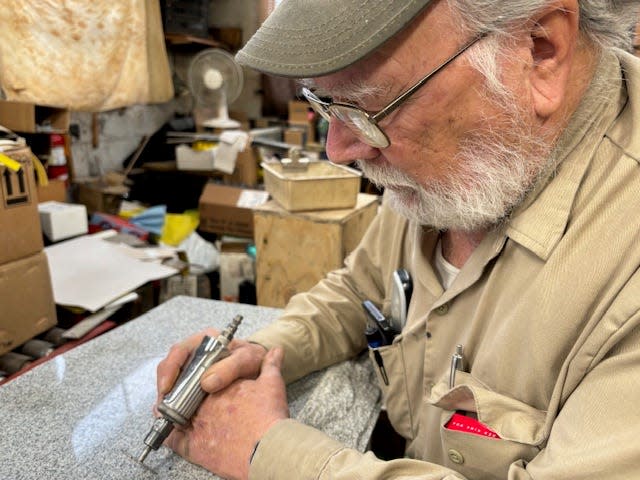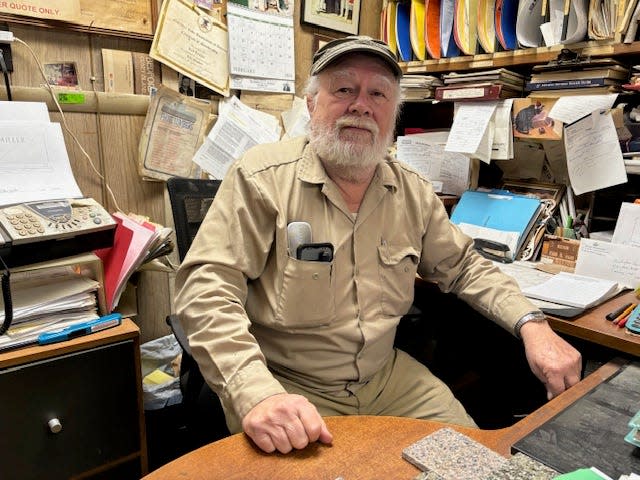Etched in stone: Leo LeClair is a fifth-generation artisan
LAMBERTVILLE — Leo LeClair’s artistry is on permanent display in more than 2,000 locations.
That’s the number of cemeteries and public places in Monroe and scattered throughout the country where you’ll find memorials created by LeClair, 73, owner of LeClair Monuments in Lambertville.
He’s the last in a long line of family stone carvers in a family business that traces its roots back to England.
A self-taught, fifth-generation artisan, he credits working side-by-side with his grandfather, the late George Tobin, with nurturing an artistic talent evident at an early age.
“I was drawing flowers at age 12, started working the stone side-by-side my grandfather at 14, and became his full-time business partner when I was 19, ” Leo LeClair said.

In his cluttered office and workshop crammed with dusty reminders that imbue the space with a sense of timelessness, LeClair, in his denim work clothes and ever-present cap, portrays himself as a plain-spoken individual who “doesn’t wear $1,000 suits” and is “too involved in my work to the point where I find it difficult to take time off: I always need to be doing something.”
That wasn’t always the case. With a hint of regret, he ruminates about youthful yesterdays “riding my motorcycle up north with friends, snowmobiling, and enjoying Upper Peninsula nature, particularly the waterfalls.”
In a business often perceived as a realm devoid of emotions and profit-driven, Dorothea Goodwin of Ann Arbor, 64 and a freelance artist specializing in headstone etchings who’s worked with Leo for over 30 years, portrays Leo as “deeply empathetic, kind, and helpful who goes above and beyond” in prioritizing the needs of grieving families.
The centuries-old art of headstone carving became a dying practice after the Civil War, when new means to mass produce headstones in response to the war’s massive death toll were introduced.
Subscribe Now: For all the latest local developments, breaking news and high school sports content.
The profession has experienced a decline over the years due to changes in burial practices, the rise of cremation, and the increasing use of technology. Modern carving techniques integrate technology into design and production.
The process of hand-carving a headstone, a labor-intensive craft, requires a high-level of technical skill, patience, attention to detail, and a deep understanding of the stone being used. Granite, the popular choice, is not created equal. Natural fissures, veins, and other flaws can complicate the carving process.
“You have to understand what each stone is going to do when you start. Sometimes you get tricked making it necessary to start all over.”
The stones arrive by the tons at Leo’s shop in slabs from quarries primarily in Georgia. An automated sand-blaster is used to spit a grit of zinc and aluminum oxides at a stone inside a closed booth, eroding in minutes rock that takes nature ages to wear away. The future memorial, then cut to the desired size and dimensions, is on its way to LeClair’s workbench.
It’s a difficult and physically demanding way to carve out a living, but one in which LeClair finds meaning and purpose in helping someone in mourning design a personal and lasting memorial to a loved one and then putting in the time and effort to creating it. His hands-on approach is a source of pride.
“Call it an ego trip or whatever, but there are times after completing a work that I step back, admire it, and compliment myself on a job well done," he said.

LeClair personally delivers and positions his headstones in nearby cemeteries, navigating different myriad regulations and restrictions imposed by each one.
“There are times with a monument needs to be placed in time for a service and, for example, the ground is wet from rain. It helps to have long-term personal relationships with the gatekeepers to gain access,” LeClair said.
His workmanship isn’t confined to headstones. You’ll find a 60 foot wall topped with etchings of the stations-of-the-cross in St. Anthony Cemetery in Lambertville and a boulder honoring indigenous peoples in West County Park Prairie Preserve in Dundee, among other lasting reminders.
Janet Rising, Petersburg, 63, LeClair’s office manager, describes herself as self-taught in psychology after 40 years of often being the first one encountered by grieving customers.
When dealing with a wide range of customers in various stages of grief, Rising said, “You have to keep in mind that this is a business and approach each situation with the same level of professionalism and attention to detail that individuals seeking a service would receive from any other business.”
LeClair echoes that sentiment.
“If individuals want to talk, I’ll listen, ” he said.
There are times when LeClair has counseled overly distraught customers to “leave, take the necessary time, and come back when they’re not so distressed that they can’t make logical emotional and financial decisions.”
Then there’s the occasions when grieving individuals make LeClair the target of their anger for having lost a loved one. He offers a unique perspective: “Perhaps they didn’t treat the deceased properly in life, so they take it out on me.”
His inclusive one-price policy is based on the belief that grieving families should never have to worry about hidden fees or unexpected expenses. He also doesn’t discourage shopping around.
“I tell customers if they can find a better price, go for it,” he said.
While he’s usably able detach his emotions when carving headstones for family members and close friends, some are particularly wrenching.
The day his mother, Beverly, passed away at age 68, LeClair worked from 6 p.m. to early morning channeling his energies into the creation and delivery of her headstone in time for her memorial service.
“I knew if I didn’t do it right away, it probably wouldn’t get done for the next 20 years,” he said.
Many individuals postpone ordering a headstone because the process symbolizes the finality of death and confronts individuals with the reality of their loss. They also are bombarded at the time with decisions from funeral arrangements to legal matters leading to decision fatigue.
When he’s able to squeeze in time to travel, his keen eye for precision in stone doesn’t take a rest.
“Mt. Rushmore in South Dakota is my favorite national monument, a true treasure," LeClair said. "Seen from a distance, it appears smooth. But up-close, you can see fissures and irregularities caused by time and weather.”
After years of advising and designing memorials for countless others, LeClair is prepared to commence work on one for himself and Patricia, his wife of 40 years. Complicating matters, however, despite lengthy discussions.
“We can’t agree on the size, color, and inscription,” he said, with a chuckle.
— Mike Kiefer can be reached at mikekiefer12@gmail.com.
This article originally appeared on The Monroe News: Etched in stone: Leo LeClair is a fifth-generation artisan

